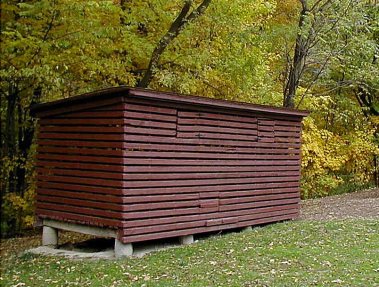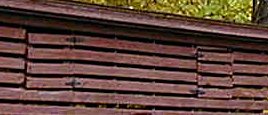18-year-old Helena Muffly wrote exactly 100 years ago today:
Tuesday, October 7, 1913:
10/6 – 10/8: I’ve husked about ten loads of corn by this time. My hands are sore and roughened, but I didn’t care very much. I’m thinking of what I’m earning.

Her middle-aged granddaughter’s comments 100 years later:
(This is the second of three days that Grandma combined into one diary entry.)
After the corn was harvested and husked, the corn ears would have been stored in a corn crib. Corn cribs had wooden slats that let the air circulate to dry the corn.
Did Grandma also have to shovel the husked corn from the wagon into the crib? Corn was shoveled in through small doors near the top of the crib. Whew, I get tired just thinking about shoveling corn into the crib.


.

What a huge job. We forget how hard farming was and still is. Thanks for showing photos of the corn crib.
Farmers work hard–but most seem to enjoy it.
The only corn cribs I’ve seen in our area have been taller and have a little different shape, but I’m not sure they were used with elevators (they look to have been from an earlier time…)
I found this picture on Wikipedia–but most corn cribs that I’ve seen are narrower (and often along the edge of a barn or other building).
Well just think of the fabulous slim waist you’d get from shovelling tons of corn into a crib. I wonder how they kept the mice out? We had a mouse in the house last night, I think it came in thru the garage when I drove in. Exciting for a while…hehe
Yeek!–I guess it’s the time of year when mice decide to move indoors.
Mice were often a problem with these old corn cribs. Corn cribs were generally raised up a little–and sometimes had metal flashing along the bottom edge–in an attempt to keep mice out, but I don’t think that it worked very well.
I have never seen a corn crib before. Interesting!
When I was a child it seemed like every farm in Pennsylvania had a couple corn cribs. Back then corn was harvested on the cob by a corn picker. Nowadays, corn is shelled by a combine when it is harvested and then the shelled corn is stored in a metal bin.
I love the connection you have with your past and the photos you share from today and speculate about!
I have a lot of fun pulling everything together for this blog. Actually some of the comments I received yesterday, when I wrote about how much corn Grandma had husked, made me realize that some people were wondering what happened next to the corn–and “ta da” I had a topic for today’s post.
I wonder what she has in mind for the money she’s making.
You’ll have to stay tuned to find out. 🙂
Love the picture of your grandma’s house and the corn crib. How blessed you are to have your grandma’s diary.
I am very fortunate to have her diary.
Lots of hard work needed to finish the harvest season.
Harvesting and planting are the busiest times of the year on a farm–and it’s all so dependent upon the weather.
I don’t think I have ever sen a corn crib. I always learn from your posts.
I have fun with this blog. I’m glad that you are learning new things.
This blog is an interesting idea. I do our family genealogy. I never thought to bring it out in the open like this. You are creative.
Thank you! This blog has provided a wonderful opportunity to reconnect with relatives that I hadn’t seen in years.
Farming is really hard work even today not mention the uncertainty of the weather and last but not least the critters..
You’re absolutely right–farmers have to deal with a lot of risk and uncertainty.
So much hard work and still no vacuum cleaner, washing machine or a nice shower. Beautiful photos btw
It’s amazing how few of the modern conveniences most people had a hundred years ago.
This reminded me that I have been wanting to write up about my Great-Grandfather’s corn crib. Thanks to you I finally posted it – you can see it here if you wish: http://en.wordpress.com/read/blog/id/32979017/
I’m glad you found this post motivating. And, thanks for sharing the link. I really enjoyed reading your post about your Great-Grandfather’s corn crib.
Hmm, my church mice would not know about corn cribs, but Mrs. Middlejoy has a sister who married and went off with her husband as missionaries to the field mice. I’m sure there is a corn crib adventure in their story…
🙂
never knew it to be called a crib. it’s more like a small barn
According to the Free Online Merrium Webster dictionary, one definition of a crib is a small building used for storage. Crib sure has a lot of different meanings from “a small bed to high sides for a baby” to “a manger for feeding animals” to “something used for cheating on an examination” to . . . . .